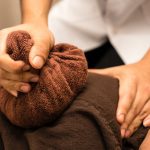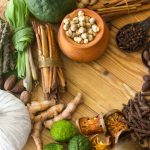- Introduction: From the wok to the wellness shelf
- The Thai way: How kitchens became clinics
- Quick wins: When to reach for what
- Lemongrass (ตะไคร้): Digestion’s bright, citrusy helper
- Kaffir (Makrut) Lime (มะกรูด): Detox’s zesty friend
- Holy Basil / Tulsi (กะเพรา/ทูลสิ): The calm in a cup
- Building your personal apothecary: Stocking, storing, brewing
- How the pieces fit: Digestion, detox, and stress in daily rhythm
- Recipes you’ll actually make
- Culture corner: Respecting roots while modernizing routines
- Who should be cautious?
- 7-day starter plan (print or save)
- Beyond the big three: Other Thai heroes to know
- Evidence snapshot (plain-language, practical)
- Market guide: Buying like a local
- Rituals that stick: Morning, noon, and night
- Common myths, gently corrected
- Kitchen math: Simple tea ratios
- Pairing with Thai massage and breath
- Make it yours: Swaps and flavor tweaks
- Glossary (quick Thai terms you’ll see)
- A simple framework for new goals
- How to write about this responsibly (for bloggers and shop owners)
- Conclusion: Small rituals, big returns
- Frequently asked questions
Introduction: From the wok to the wellness shelf
If you grew up in Thailand—or anywhere that loves bold flavors—you already know that Thai cooking doubles as everyday care. A pot of tom yum clears the head, a squeeze of lime wakes the senses, and a tulsi (holy basil) tea can be the calm after a long day. This guide brings that living wisdom together and translates it into practical routines you can use at home. We’ll focus on three stars: lemongrass for digestion, kaffir (makrut) lime for gentle detox rituals, and holy basil for stress relief. Along the way, we’ll connect kitchen habits with wellness goals so you can turn simple recipes into repeatable self-care.
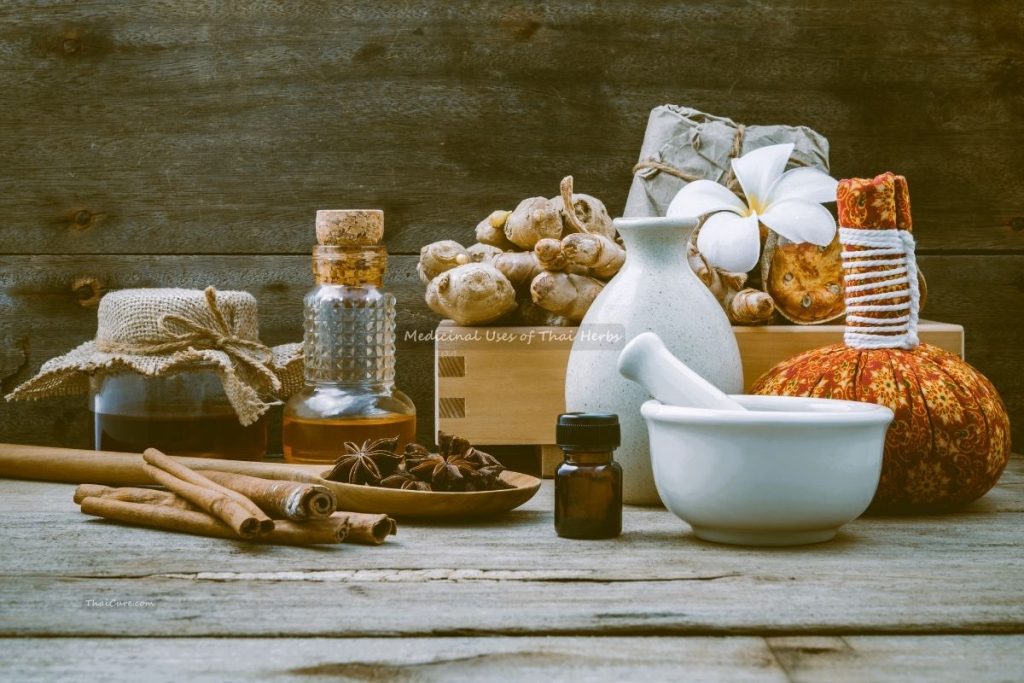
In Traditional Thai Medicine (TTM), balance is the aim. Food is the first pharmacy, and seasonal ingredients are the core tools. By understanding the medicinal uses of Thai herbs, you’ll be able to create simple tonics, teas, and aromatics that match your needs, whether you’re easing a heavy meal, clearing mental fog, or winding down before bed. If you’re searching for thai herbs for health, this article is your field guide.
Note: This article is educational and not medical advice. Always check with a healthcare professional if you have a condition, take medication, are pregnant, or plan remedies for children.
👉 “Feeling inspired to bring Thai healing into your daily life? Don’t miss our practical guide on Daily Self-Care Routine for Mental and Physical Wellness.”
The Thai way: How kitchens became clinics
Before there were pharmacies on every corner, the village kitchen was the lab. TTM blends Ayurveda, Chinese theory, and local plant knowledge with Buddhist principles of moderation and mindfulness. Recipes carry stories: your grandmother’s lemongrass tea for a travel-tired stomach; your neighbor’s kaffir lime hair rinse before big festivals; the temple herbal inhaler that brings you back to center during a stressful week. In this setting, the medicinal uses of Thai herbs are never separate from daily life; they’re woven into it.
Think of the four elements in TTM—Earth, Water, Wind, Fire—as forces to balance. Digestive discomfort is often framed as “wind” stuck in the belly; stress shows up as excess “fire” in the mind. The kitchen remedies below aim to balance these elements in gentle, repeatable ways. If you’ve been looking for herbal remedies Thailand, you’ll recognize many of these preparations, just explained with modern clarity.
👉 “For a full list of essential herbs, see our guide: Discover the 7 Thai Herbs Every Chef Needs to Know.”
Quick wins: When to reach for what
- After a heavy meal, bloating, or travel tummy: get lemongrass on the stove.
- Feeling puffy or dulled after late nights: make a kaffir lime water infusion or steam.
- Wired and tired, or pre-sleep jitters: brew holy basil (tulsi) tea.
These simple choices reflect the everyday medicinal uses of Thai herbs and fit neatly into busy homes.
Lemongrass (ตะไคร้): Digestion’s bright, citrusy helper
Why Thai cooks love it: Lemongrass is a classic carminative, meaning it helps move gas and relax the gut. Its citrus-pine aroma lifts heavy dishes and settles a queasy stomach. If your goal is thai herbal remedies for digestion and stress, lemongrass is often step one for the digestion half of that duo.
Kitchen-to-healing basics
- Tea for bloating: Slice 2–3 fresh stalks (or 2 tbsp dried). Simmer 10–12 minutes. Optional: add a coin of galangal. Sip warm after meals.
- Soup booster: Smash stalks and add to broths or rice porridge. Remove before serving.
- Digestive syrup (for mocktails): Simmer equal parts water and sugar with lemongrass until fragrant; keep in the fridge for 1 week; add a squeeze of lime.
Mini-routine for travelers
- Day 1: Lemongrass tea morning and evening.
- Day 2: Light rice porridge with lemongrass and ginger.
- Day 3: Keep tea, add a walk after meals; focus on warm, brothy foods.
Safety & notes
Lemongrass is generally gentle, but essential oil is potent—avoid ingesting concentrated oils. If pregnant or on diuretics, moderate intake and consult your clinician.
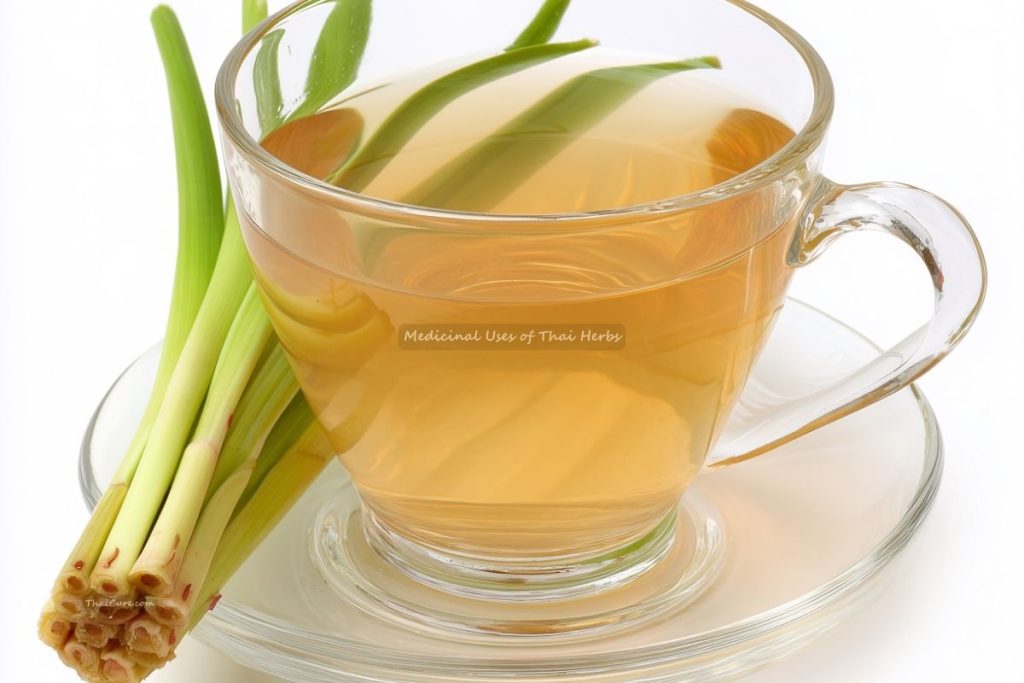
These everyday uses sit squarely within the medicinal uses of Thai herbs, especially for digestion relief. If you’re building a pantry of thai herbs for health, lemongrass should be near the front.
Kaffir (Makrut) Lime (มะกรูด): Detox’s zesty friend
Why it’s special: The leaves perfume curries; the rugged green fruit provides zest, juice, and a fragrant peel. In folk practice, kaffir lime is used to refresh the scalp, clear kitchen smells, and “lift” the body after a period of lethargy. In many communities, herbal remedies Thailand often include a makrut lime bath or steam after celebrations.
Kitchen-to-healing basics
- Detox water: Lightly crush 2–3 leaves and a thin peel strip; steep in cool water 30 minutes. Sip through the day.
- Steam for clarity: Add peel and leaves to a bowl of hot water; tent with a towel and breathe gently for 3–5 minutes.
- Scalp rinse: Warm water infused with peel; pour over scalp after shampooing; rinse out.
Safety & notes
Citrus peel can be photosensitizing as an essential oil—avoid direct sunlight after using concentrated oils on skin. The kitchen infusions above are mild.
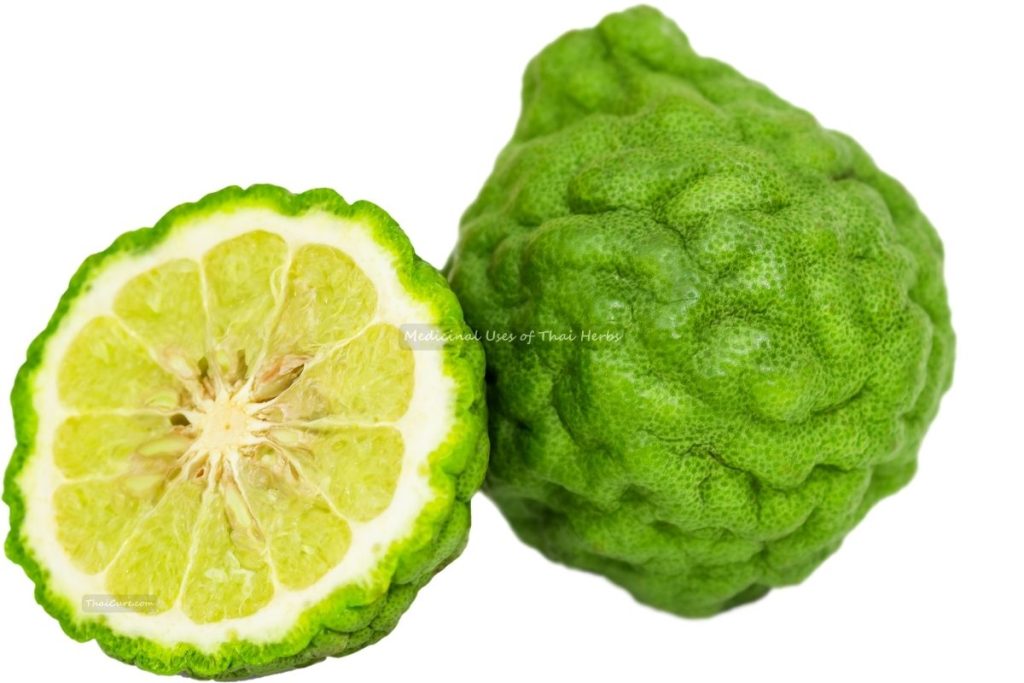
When energy feels stagnant, a kaffir-lime ritual can reset your senses. It’s another doorway into the medicinal uses of Thai herbs—especially when you’re chasing light, detox-leaning routines among thai herbs for health.
Holy Basil / Tulsi (กะเพรา/ทูลสิ): The calm in a cup
Why it’s revered: Holy basil is an adaptogen in many traditions, favored when stress levels crest. Its peppery scent and gentle bitterness make a soothing tea that doesn’t sedate. For many readers searching thai herbal remedies for digestion and stress, tulsi addresses the “stress” side while also helping a tense gut.
Kitchen-to-healing basics
- Evening tea: 1–2 tsp dried holy basil or a handful fresh; steep 8–10 minutes.
- Inhale & reset: Rub fresh leaves between fingers, breathe in for three slow breaths.
- Spicy calm stir-fry: Gently wilt holy basil into a vegetable stir-fry; keep heat low to preserve aroma.
Safety & notes
Holy basil can interact with blood-sugar or anticoagulant medications; if you take prescription meds, check with your clinician. The tea described here is culinary-strength and widely used.
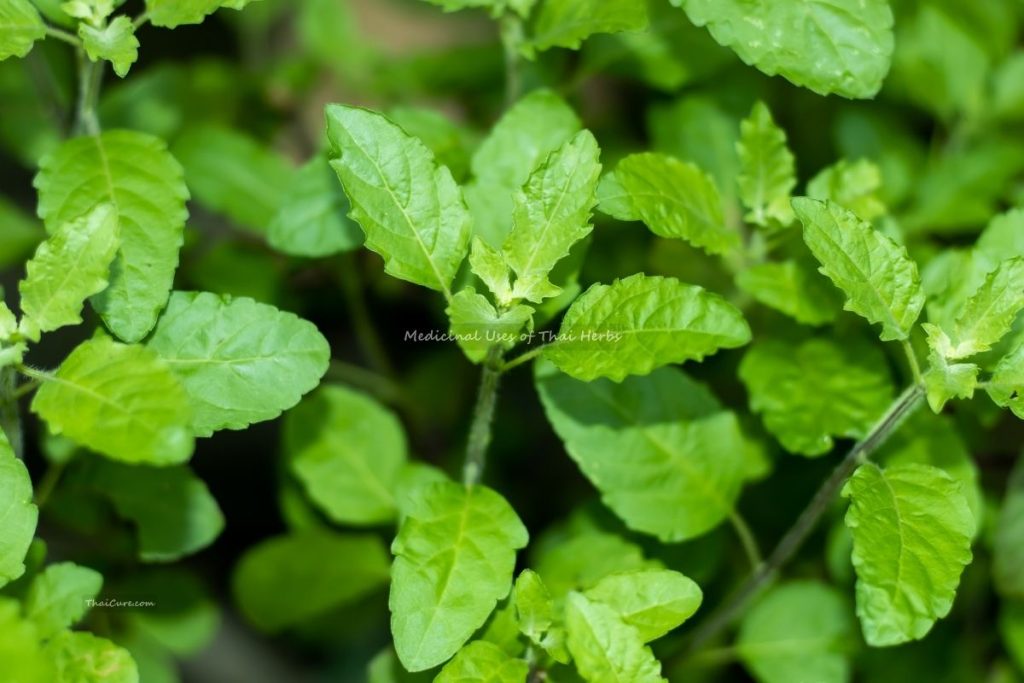
Many people begin their journey into the medicinal uses of Thai herbs with tulsi because its effects are felt in mood and digestion both—a practical win for thai herbs for health seekers.
Building your personal apothecary: Stocking, storing, brewing
If you want an everyday corner for herbal remedies Thailand, start by stocking a small crate in the kitchen:
- Fresh lemongrass (keep stalks in a jar of water in the fridge; trim bottoms weekly).
- Kaffir lime leaves and a couple of fruits (freeze leaves between parchment; zest fruit before juicing).
- Holy basil (use fresh within 3 days; dry extra leaves on a tray in the shade).
- Companions: ginger, galangal, pandan, Thai basil, honey, lime.
Storage tips
- Dry herbs in shade with airflow; store in amber jars away from heat.
- Label harvest/purchase dates; most dried leaves keep quality for 6–9 months.
- For teas, aim for 2–3 g herb per 250 ml water at first; adjust by aroma and taste.
Creating this shelf is a concrete expression of the medicinal uses of Thai herbs: inviting flavor to do double duty as care.
How the pieces fit: Digestion, detox, and stress in daily rhythm
Here’s a gentle weekly rhythm tying together thai herbal remedies for digestion and stress:
- Mon–Tue (reset): Lemongrass tea after lunch; lighter dinners with broth.
- Wed–Thu (clear): Kaffir lime water bottle on your desk; one quick steam in the evening.
- Fri–Sun (calm): Holy basil tea after sunset; slower, earlier meals; a phone-free hour before bed.
This rotation shows the medicinal uses of Thai herbs as habits rather than one-off fixes. Over time, these small practices support your broader goals with thai herbs for health.
Recipes you’ll actually make
1) Lemongrass & Ginger Belly-Soothing Tea
- 2 lemongrass stalks, sliced
- 3 thin ginger coins
- 300 ml water, simmer 12 minutes; rest 3 minutes
- Optional: 1 tsp honey, 1 tsp lime juice
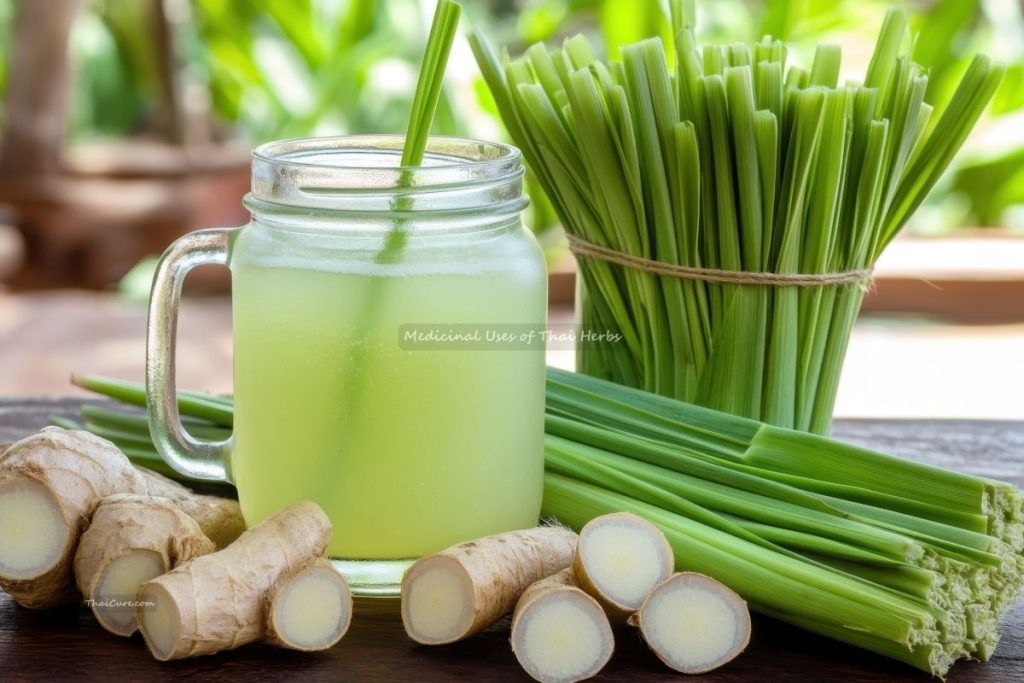
Why it works: Lightly warming, carminative, and aromatic—classic digestion support within the medicinal uses of Thai herbs.
2) Makrut Lime Morning Detoxy-Spritzer
- 1 strip makrut lime peel, 2 leaves, lightly crushed
- 400 ml room-temp water; infuse 30–60 minutes
- Add a splash of soda water right before drinking
Why it works: Gentle “wake-up” without caffeine; a sensory reset used in many herbal remedies Thailand routines.
3) Tulsi Good-Night Tea
- 1–2 tsp dried holy basil (or a small handful fresh)
- 300 ml hot water; steep 8–10 minutes
- Optional: a slice of pandan for aroma
Why it works: Settles the mind and releases tension—core to thai herbs for health when evenings get busy.
Culture corner: Respecting roots while modernizing routines
When we speak about the medicinal uses of Thai herbs, we also honor the people who carried these practices forward—market vendors who teach you how to bruise lemongrass correctly, elders who save kaffir seeds for next season, and monks who distill quiet into a cup of tulsi tea. In Thailand, healing is communal: food is shared, remedies are demonstrated in kitchens, and rest is not a luxury but a rhythm. Translating herbal remedies Thailand into global kitchens means keeping this spirit of care—choosing patience over quick fixes, and flavor over force.
Who should be cautious?
- Pregnancy & breastfeeding: prefer culinary quantities; avoid essential oils internally.
- Chronic conditions: if you manage blood pressure, blood sugar, or clotting, consult your clinician before adding daily teas.
- Allergies: citrus family sensitivities apply to kaffir lime; always start small.
Caution is part of the medicinal uses of Thai herbs—using them thoughtfully keeps tradition intact and you safe.
7-day starter plan (print or save)
Goal: turn knowledge into repeatable habits.
- Day 1 (Lighten up): Lemongrass & ginger tea after lunch; walk 15 minutes.
- Day 2 (Support): Lemongrass broth with rice porridge; evening stretch.
- Day 3 (Refresh): Makrut lime spritzer on desk; 3-minute steam before shower.
- Day 4 (Balance): Continue spritzer; eat a colorful, fiber-forward dinner.
- Day 5 (Unwind): Tulsi tea at sunset; journaling or quiet reading.
- Day 6 (Repeat): Choose your favorite of the three and repeat.
- Day 7 (Reflect): Note what helped—this is your personalized map of the medicinal uses of Thai herbs.
Beyond the big three: Other Thai heroes to know
- Galangal: warm, peppery; soothes heavy meals; wonderful in broths.
- Ginger: classic nausea support; pairs well with lemongrass in travel teas.
- Pandan: calming aroma for evening teas and rice; child-friendly.
- Turmeric: warming spice in curries; many use it for joint comfort; always pair with black pepper in cooking.
These “bench players” expand the medicinal uses of Thai herbs into more meals and moments.
Evidence snapshot (plain-language, practical)
When you read about the medicinal uses of Thai herbs, you’ll also see modern science exploring why traditional kitchens noticed these effects. Lemongrass is widely used as a carminative; holy basil appears in many studies for mood and stress; citrus peels are valued for refreshing aroma and digestive brightness. You don’t need to memorize chemistry to use them—taste and routine are your guides. Keep your brews mild, listen to your body, and increase strength slowly. This is the heart of thai herbs for health at home.
Market guide: Buying like a local
If you’re in Thailand, dawn is the best time to buy herbs—cooler temps keep leaves perky. At wet markets, look for:
- Lemongrass: tight, pale bases; firm, aromatic stalks; avoid dry, hollow centers.
- Kaffir lime leaves: deep green, glossy, with a snap when bent; choose pairs that are intact.
- Makrut lime fruits: heavy for size; bumpy skin; vibrant fragrance when scratched.
- Holy basil: small, slightly hairy leaves; peppery aroma; avoid blackened stems.
Vendors love explaining the medicinal uses of Thai herbs—ask how they brew tea or which dish eases a tummy. If you’re abroad, Asian grocers and Thai shops often carry frozen leaves that work beautifully for herbal remedies Thailand routines.
Rituals that stick: Morning, noon, and night
- Morning (refresh): Makrut lime water while you prep breakfast. Spend 30 seconds breathing in the scent before the first sip.
- Mid-day (digest): Lemongrass tea after your most substantial meal. Eat at a slower pace; pause screens.
- Evening (unwind): Holy basil tea; dim lights; short stretch. Keep a “no email after tea” rule.
By tying beverages to times of day, you naturally repeat the medicinal uses of Thai herbs without tracking apps or guilt. Over a month, these small rituals anchor your plan for thai herbs for health.
Common myths, gently corrected
- “Detox” must be extreme.” In Thai homes, detox is often sensory—steam, scent, and light hydration. Gentle practices fit the medicinal uses of Thai herbs far better than harsh cleanses.
- “Stronger is better.” Essential oils and extracts can irritate; the kitchen path is mild, steady, and delicious.
- “Herbs replace doctors.” Traditions sit alongside modern care. Use them together, especially when stress, sleep, and digestion are the goals of your herbal remedies Thailand plan.
Kitchen math: Simple tea ratios
For a 300 ml cup, a friendly starting point is 2–3 g dried leaves (about 1 heaping teaspoon) or a small handful fresh. For stalky herbs like lemongrass, slicing exposes aroma—bring to a simmer, then rest a few minutes. This practical brewing is where the medicinal uses of Thai herbs become a daily craft instead of a theory.
Pairing with Thai massage and breath
Many spas pair herbal steams and compresses with massage to amplify calm and circulation. At home, try this 4-minute breath routine while your tea steeps: inhale 4, hold 2, exhale 6, hold 2—repeat five times. Linking breath, warmth, and aroma makes the medicinal uses of Thai herbs more tangible, especially for thai herbal remedies for digestion and stress.
Make it yours: Swaps and flavor tweaks
- Prefer floral? Add pandan to tulsi tea.
- Need a bolder tummy soother? Add a tiny pinch of toasted cumin with lemongrass.
- Hate bitter notes? Sweeten with honey or palm sugar, but keep portions small to preserve the wellness aim of thai herbs for health.
Glossary (quick Thai terms you’ll see)
- ตะไคร้ (ta-khrai): lemongrass
- มะกรูด (ma-krood): kaffir/makrut lime
- กะเพรา (ga-phrao): holy basil / tulsi
- ยาสมุนไพร (ya-sa-mun-phrai): herbal medicine
Learning the words deepens respect and keeps the medicinal uses of Thai herbs tied to their cultural home.
A simple framework for new goals
When you set a new health intention—better digestion after travel, calmer evenings during busy quarters—choose one herb, one preparation, and one time of day. Stick with it for 7–10 days. This small-step approach is the most reliable path into the medicinal uses of Thai herbs and the broad, welcoming world of herbal remedies Thailand.
How to write about this responsibly (for bloggers and shop owners)
If you plan to teach others or sell products, keep to culinary-strength advice, cite credible sources when making strong claims, and encourage personalization. The heart of the medicinal uses of Thai herbs is not a miracle cure; it’s daily, kind routines aligned with season, schedule, and taste.
Conclusion: Small rituals, big returns
The path from wok to well-being is short when you know what to reach for. Lemongrass eases the belly after long days, kaffir lime offers a sensory reset, and holy basil helps you exhale. Thread them into teas, soups, steams, and quiet pauses, and you’ll feel the shift. Whether you came for thai herbs for health or to explore herbal remedies Thailand, the medicinal uses of Thai herbs are waiting in your kitchen—simple, aromatic, and rooted in respect.
Frequently asked questions
1) Can I combine these herbs in one tea?
Yes. A classic trio is lemongrass + ginger + holy basil. Start mild, then adjust. This still counts within the medicinal uses of Thai herbs and fits many thai herbs for health routines.
2) What’s the difference between Thai basil and holy basil?
Thai basil (โหระพา) is sweeter and often used in pho and stir-fries; holy basil (กะเพรา) is peppery, used for alert calm. For stress support, tulsi (holy basil) is the one most people choose.
3) What if I can’t find kaffir (makrut) lime?
Use regular lime peel with a strip of lemongrass; aroma is different but bright. You’ll still be practicing the medicinal uses of Thai herbs with substitutions.
4) Are there side effects?
Culinary quantities are usually gentle; concentrated extracts and essential oils are stronger and may irritate skin or interact with medications. “Start low and go slow” is the Thai kitchen motto for herbal remedies Thailand.
5) Can kids try these teas?
Small, mild amounts are commonly used in Thai homes, but every child is different. Offer a few sips of weak tea, watch reactions, and check with a pediatric clinician if uncertain.


